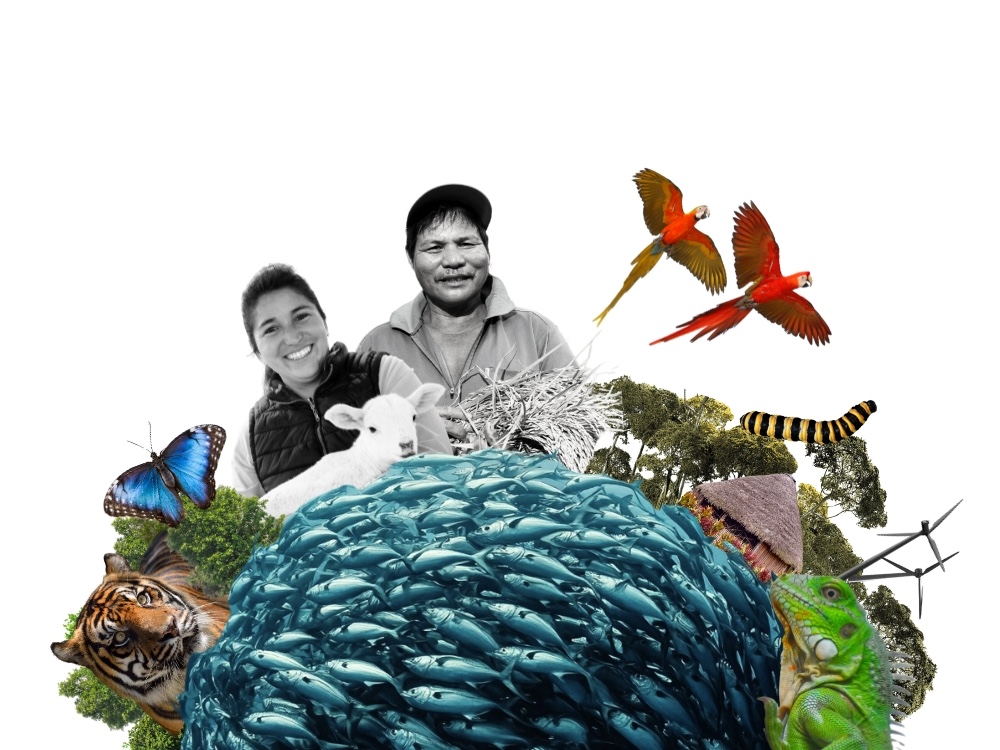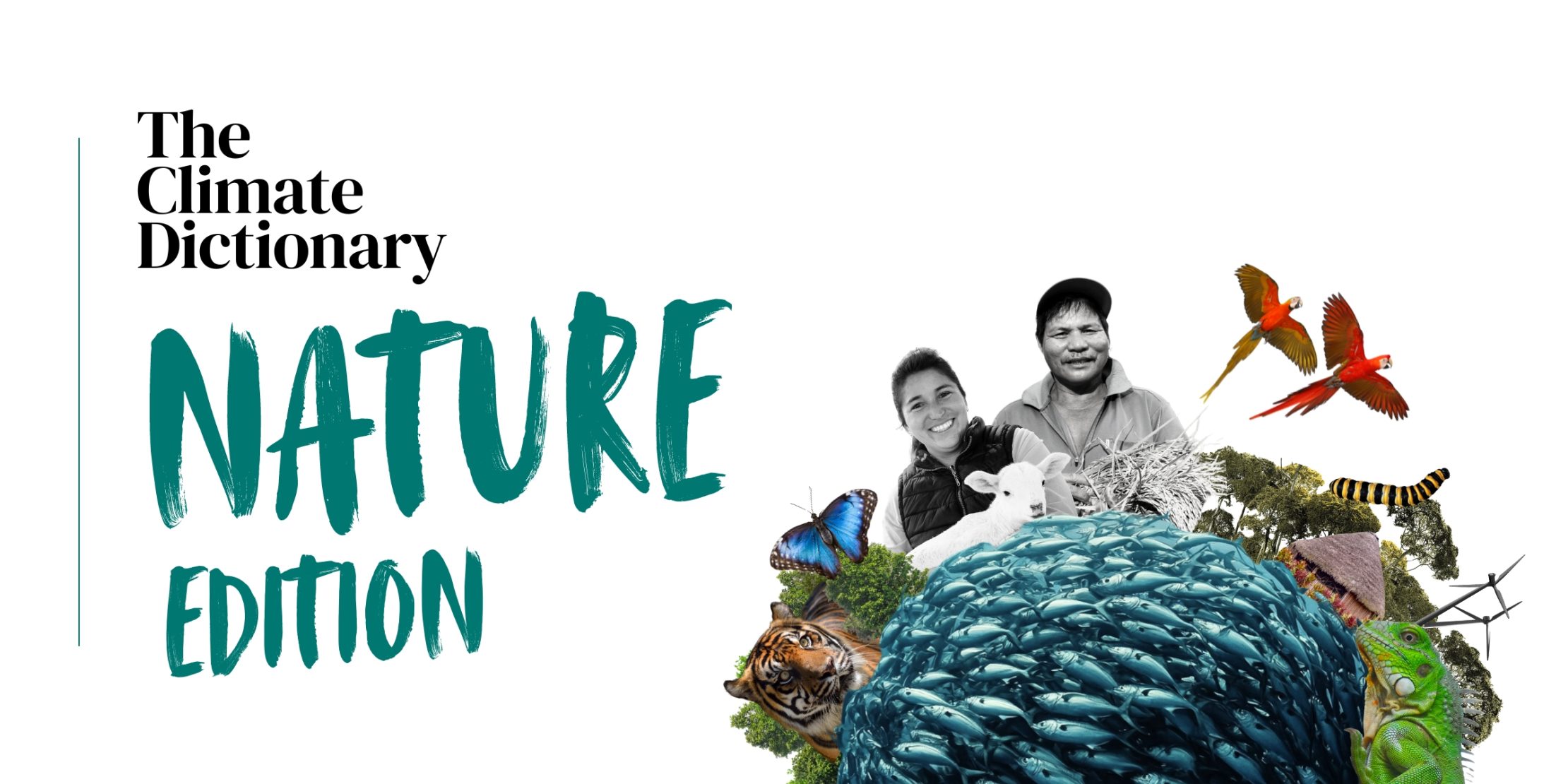
Find out more about UNDP’s nature work, news and progress of global environmental action at undp.org/nature.
Our relationship with our natural world is broken. We are currently using resources equivalent to 1.7 Earths, far beyond what the planet can regenerate.
This is why it is important that more and more people get involved in action to protect and restore nature and biodiversity.
If you are new to environmental action or have been following climate change news but are less familiar with the nature and biodiversity crisis, then this guide to some of the most frequently used and important terms and concepts is for you.
We invite you to read it, bookmark it, and share it with anyone who might find it useful.

The nature crisis refers to the rapid and dangerous decline of the world’s natural resources and stability of our ecological systems over the past century. It is driven by human activities such as deforestation, overfishing and pollution, which are linked to unsustainable patterns of production and consumption and a growing human population. At its roots, the nature crisis stems from the ways we underestimate the value of nature in our global systems and daily lives.
Humanity is currently using resources equivalent to 1.7 Earths, which is far beyond what the planet’s ecosystems can regenerate. This consumption is much higher in high-income countries than in low- or middle-income ones and drives the triple planetary crisis of biodiversity loss, climate change and pollution.
Nearly two million of Earth’s estimated eight million species of plants, insects and animals face the threat of extinction, and over 75 percent of ice-free land, 66 percent of marine environments and 85 percent of wetlands have been significantly altered by human actions. To shift from nature-negative to nature-positive, humanity must conserve and restore a lot more of the planet’s land, water and oceans, adopt regenerative agriculture practices, transition to sustainable patterns of production and consumption, and assign financial values to nature’s services so that they can be prioritized in policies and investments.

Planetary boundaries define the Earth's limits of resources and protective systems that create a safe operating space for humanity. Planetary boundaries quantify the vulnerability of Earth’s life-supporting systems and explain the constraints on economic and population growth necessary to also maintain a stable environment. These boundaries challenge dominant economic views of an Earth with limitless capacity, highlighting that our development and survival are bound by ecological limits.
Nine processes regulate the stability and resilience of the Earth’s system and there is a quantified planetary boundary for each. As of 2023, six boundaries—climate change, biosphere integrity, land system change, freshwater use, biogeochemical flows and novel entities (like human-made chemicals and plastics)—have already been crossed, posing serious risks to humanity and all life on Earth. Ocean acidification is also approaching a critical threshold.

Land degradation occurs when human activities exploit land leading to a decline in its usefulness, biodiversity, soil fertility and overall health. Land degradation has far-reaching consequences, disrupting rainfall patterns, increasing the frequency and intensity of extreme weather events like droughts and floods, and limiting the carbon storage potential of ecosystems and soils. These impacts affect food security and the social and political stability of communities and can lead to increased poverty, conflict and migration.
If the current rate of land degradation continues, 90 percent of the world's land could be classified as degraded by 2050. Land degradation neutrality (LDN) is a state where the quantity and quality of land resources needed to support ecosystem functions and services remain stable or improve over time and across different locations and ecosystems. Land degradation neutrality can be achieved by adopting sustainable land management practices, transitioning to regenerative agriculture and restoring nature and degraded ecosystems. This is crucial to ensuring food security for a human population of over eight billion, as current agricultural practices degrade soils up to 100 times faster than they can regenerate through natural processes.
The United Nations Convention to Combat Desertification (UNCCD) aims to achieve land degradation neutrality by halting and reversing this trend. It supports 131 countries committed to stopping land degradation by 2030.
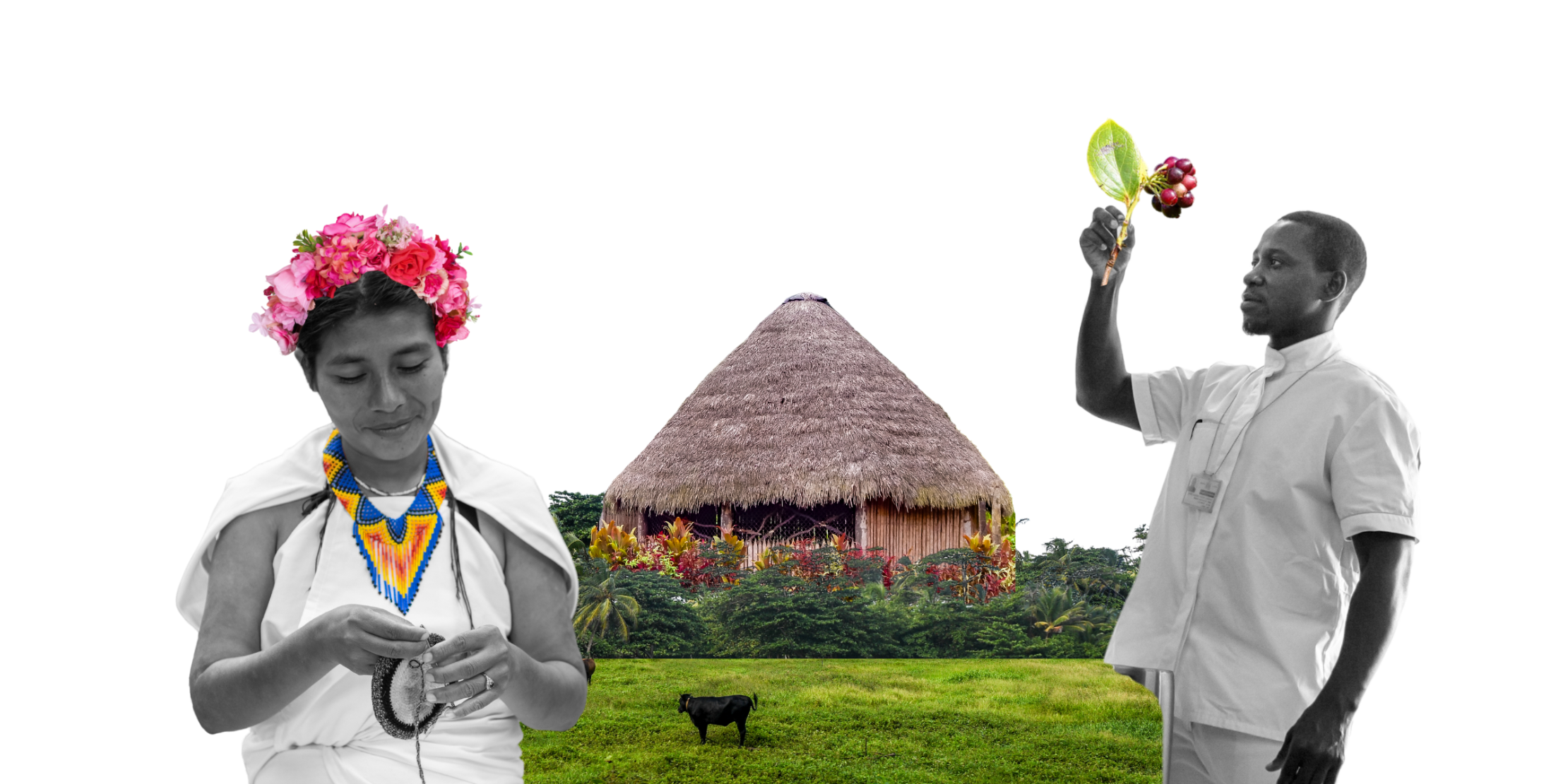

A biodiversity hotspot is a region with very high diversity of species which are both irreplaceable and threatened by biodiversity loss. Hotspots are defined as having at least 1,500 species of plants that occur nowhere else on Earth, and which have lost at least 70 percent of their original, natural vegetation.
Hotspots are the world’s most biologically rich areas, containing nearly 50 percent of all unique plant species and about 35 percent of bird, mammal, reptile and amphibian species. Yet, they are deeply threatened.
There are currently 36 biodiversity hotspots around the world. Although biodiversity hotspots are estimated to have once covered more than 15 percent of the world’s land, their habitats have now been reduced to about 2.5 percent, due to human action and exploitation. Climate change is further destabilizing these ecosystems and accelerating habitat loss. Protection and restoration of biodiversity hotspots are crucial for halting and reversing nature loss, protecting carbon sinks and preventing the collapse of ecosystems upon which life on Earth depends.

Environmental justice is the goal of promoting justice and accountability in environmental matters, focusing on the respect, protection and fulfilment of environmental rights for both present and future generations, and the promotion of the environmental rule of law. It supports the principle that everyone has the right to a clean, healthy and sustainable environment.
The triple planetary crisis of biodiversity loss, climate change, and pollution undermines human rights and worsens inequalities. These interlinked crises act as threat multipliers, amplifying conflicts and structural inequalities, and forcing people into increasingly vulnerable situations, particularly those from communities who are already marginalized.
The pursuit of environmental justice therefore requires equitable solutions that respect and protect human rights and take planetary boundaries into account. Such solutions include protecting the land and tenure rights of Indigenous Peoples and local communities, taking action on the right to a healthy environment on a livable planet on behalf of children and future generations, incorporating principles of just transition into efforts to transition to a nature-positive, low-emission future, and ensuring access to justice for human rights violations caused by or triggered by defending against environmental degradation and the changing climate.

Ecocide is the devastation or destruction of nature to the detriment of life, the ‘unlawful or wanton acts committed with knowledge that there is a substantial likelihood of causing severe and either widespread or long-term damage to the environment’.
Several countries have passed national ecocide laws to deter actions that cause serious environmental destruction, establishing personal criminal liability for such acts. This could mean that individuals, including corporate leaders and heads of state, could be prosecuted and face imprisonment for causing major environmental harm.
Ecocide undermines countries and societies that depend on the services provided by healthy ecosystems, such as clean air and water, pollination and food, for their survival. For Indigenous Peoples and local communities, the destruction of nature caused by resource extraction and climate change can also threaten to eradicate their cultures and ways of life. Ecocide also severely compromises Earth’s ability to support future generations and their chances of enjoying basic universal human rights.


Indigenous Peoples’ ways of life are inherently low-carbon and emphasize balance between humans and the natural world. Their traditional practices have low impact on the environment and are responsive to it, fostering self-sustaining ecosystems.
Indigenous Peoples were among the first to notice climate change and their knowledge and practices help navigate and adapt to its impacts. Indigenous knowledge, which is intergenerational and community-based, is a great source of meaningful climate solutions that can advance mitigation, enhance adaptation and build resilience. It can also complement scientific data with precise landscape information that is critical to evaluating climate change scenarios.
Indigenous Peoples and the lands they manage are essential to protecting the world’s biodiversity. Yet they continue to be largely excluded from almost all global decision-making processes on tackling climate change and the nature crisis. Their collective knowledge and valuable insights, their rights to their ancestral lands, territories and resources, and their way of life must be recognized and included across environmental policies and actions.

A green economy is an economic system that promotes human well-being and builds social equity while reducing environmental risks and resource scarcities. In a green economy, the focus is on achieving sustainable development by creating decent work and green jobs, protecting biodiversity and ecosystem services, reducing carbon emissions and pollution, promoting resource efficiency and advancing equity and fairness among different social groups and generations.
Green finance plays a crucial role in supporting a green economy by providing the necessary financial flows from public and private sources to key sectors for sustainable development such as agriculture and fisheries, water, forests, infrastructure, energy, industry, technology, transportation and tourism. In a green economy, financial investments in these sectors manage environmental and social risks, while seizing opportunities that offer both financial returns and environmental benefits and enhancing accountability in financial practices.
The green economy aims for triple benefits in economic, environmental and social areas. By harmonizing regulatory frameworks, providing public financial incentives and facilitating green financing across sectors, countries can identify positive synergies that help create a sustainable and inclusive economic system that benefits both people and nature.

The world’s oceans – their temperature, chemistry, currents, and life – drive global systems that make Earth habitable for humankind. Our rainwater, drinking water, weather, climate, coastlines, much of our food, medicines and even the oxygen in the air we breathe, are all provided and regulated by the seas. However, because of climate change, the health of our oceans is now at significant risk.
The "blue economy" concept seeks to promote economic development, social inclusion, and the preservation or improvement of livelihoods while at the same time ensuring environmental sustainability of the oceans and coastal areas.
Blue economy has diverse components, including established traditional ocean industries such as fisheries, tourism, and maritime transport, but also new and emerging activities, such as offshore renewable energy, aquaculture, seabed extractive activities, and marine biotechnology.

Regenerative agriculture is a way of farming that nurtures and restores soil health, and therefore reduces water use, prevents land degradation, and promotes biodiversity. By minimizing land ploughing, practicing rotating crops, and using animal manure and compost, regenerative agriculture ensures that the soil stores more carbon, conserves more moisture, and is healthier due to thriving fungal communities.
Intensive agriculture is responsible for a third of global greenhouse gas emissions, uses 70 percent of the fresh water we consume, and leads to soil degradation through its use of heavy machinery, chemical fertilizers, and pesticides. It is also the biggest contributor to biodiversity loss. By contrast, regenerative agriculture helps lower greenhouse gas emissions, conserves water, and restores land. Moreover, healthy soil produces more food and better nutrition and has other positive impacts on ecosystems and biodiversity.
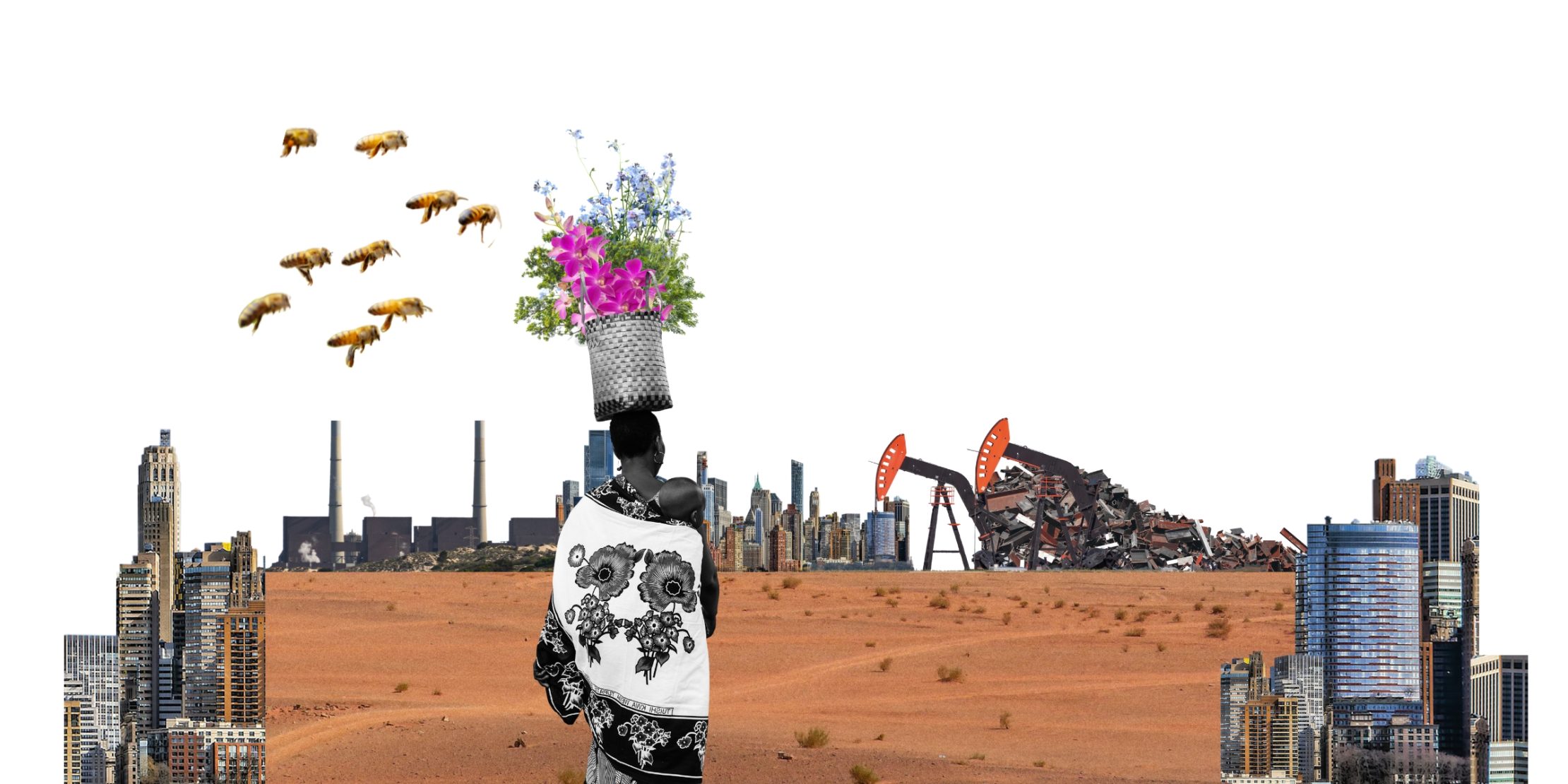

Nature-based solutions are actions to protect, conserve, restore, and sustainably use and manage ecosystems to support climate change adaptation and mitigation efforts, preserve biodiversity, and enable sustainable livelihoods. They are actions that prioritize the importance of ecosystems and biodiversity and are designed and implemented with the full engagement and consent of local communities and Indigenous Peoples, who hold generational knowledge on protecting nature.
Nature-based solutions are used in many ways, across terrestrial, freshwater, coastal, and marine ecosystems. Restoring wetlands protects communities from floods, while conserving mangrove forests supports food sources and minimizes the impact of storms. Forests absorb carbon dioxide, allow biodiversity to thrive, increase water security, and combat landslides, while urban parks and gardens help cool down cities and limit the impact of heatwaves. Regenerative agriculture practices increase the amount of carbon captured by the soil and restore its health and productivity.
Nature-based solutions are seen as a win-win for people and nature, addressing multiple problems at once. They can create jobs, provide new and more resilient livelihood opportunities, and increase income while also protecting the planet and addressing climate change.

Forests provide immense benefits by removing carbon dioxide and pollutants from the atmosphere, preventing soil erosion, filtering water, and housing half of the world’s land species of animals, plants and insects. Reforestation and afforestation are two of the most effective nature-based solutions in fighting climate change and limiting its impacts.
Reforestation is the process of replanting trees in areas that had recent tree cover but where forests were lost, due to wildfires, drought, disease, or human activity such as agricultural clearing.
Afforestation is the process of planting trees in areas that have not been forested in recent history. Afforestation helps restore abandoned and degraded agricultural lands, prevent desertification, create carbon sinks, and generate new economic opportunities for local communities.

Rewilding is the mass restoration of ecosystems that have been damaged by human activity. More than conservation, which focuses on saving specific species through dedicated human intervention, rewilding refers to setting aside large areas for the natural world to regenerate in on its own terms. This sometimes requires the reintroduction of key species that have been driven extinct in a particular region, such as beavers, wolves, or large herbivores, who help shape entire ecosystems.
Rewilding can help combat climate change by removing more carbon dioxide from the atmosphere through healthy natural processes such as natural woodland regeneration. It also helps prevent species extinction by creating nature-rich habitats that allow wildlife to adapt to climate change and migrate as warming intensifies.

A carbon sink is any process, activity, or mechanism that absorbs more carbon dioxide from the atmosphere than it releases. Forests, oceans, and soil are the world’s largest natural carbon sinks.
Oceans absorb carbon dioxide from the atmosphere through marine ecosystems and the plant and animal life they harbor. Sequestering carbon in marine ecosystems is generally referred to as blue carbon. Forests and soil are the other main natural carbon sinks of the planet, storing carbon in trees and vegetation, wetlands and peat bogs, and plant litter.
Today, human activity, like burning fossil fuels and deforestation, causes more carbon to be released into the atmosphere than the Earth’s natural carbon sinks can absorb, leading to global warming and climate change. Human activities and climate change are also causing the degradation of these natural carbon sinks, threatening the release of the carbon they store back into the atmosphere. Therefore, protecting carbon sinks and expanding their capability to absorb carbon and store it long-term is a key strategy for tackling climate change and stabilizing the climate.


Debt-for-nature swaps are financial instruments that reduce a country's external debt in exchange for commitments to protect nature and biodiversity, tackle nature loss and the climate crisis.
Often, developing countries that are heavily indebted are also highly vulnerable to environmental degradation and climate change. This creates a vicious cycle in which their debt limits the investments they can make to increase resilience to the impacts of nature loss and climate change, leaving them even more vulnerable to consequences of ecosystem collapse, vanishing natural resources and climate hazards that further compound financial strain.
Debt-for-nature swaps can help countries lessen their debt burden, while boosting their economies and contributing to their national commitments to biodiversity, climate and land targets and goals. In some countries, these swaps have reduced debt by up to 10 percent of Gross Domestic Product (GDP).
It is estimated that debt-for-nature swaps could generate US$100 billion to help restore nature and advance climate action. However, for this to happen, the volume of transactions must be scaled up significantly.

Access and benefit sharing means the fair and equitable sharing of the benefits that come from the use of genetic resources.
Many valuable genetic resources from plants, animals and microbes are found in developing countries with rich biodiversity. They have often been safeguarded by Indigenous Peoples and local communities for generations, together with traditional knowledge about their use and value. These resources can have many different purposes, including medical research, agricultural innovations, and commercial products such as cosmetics and beverages, representing significant benefits. The benefits resulting from their use can be financial, educational and cultural and should be shared fairly with the people or countries that provided them.
Without agreements to guide access and benefit sharing, these countries, Indigenous Peoples and local communities might not receive any benefits from the commercial use of their natural resources. In addition to protecting and promoting fairness, access and benefit sharing agreements also encourage the conservation and sustainable use of biodiversity.

Green jobs are decent jobs that contribute to protecting and restoring the environment and addressing climate change. Green jobs can be found in both the production of green products and services, such as renewable energy, and in environmentally friendly processes, such as recycling. Green jobs help improve energy and raw material efficiency, limit greenhouse gas emissions, minimize waste and pollution, protect and restore ecosystems, and support adaptation to the impacts of climate change.
As the market for green jobs is expanding, countries must ensure that the workforce is equipped with the specific skills and education required to carry them out. This can be achieved by investing in training young people for future green jobs and by retraining workers from carbon-intensive industries. The latter is a key part of ensuring countries are pursuing a just transition and leave no one behind.
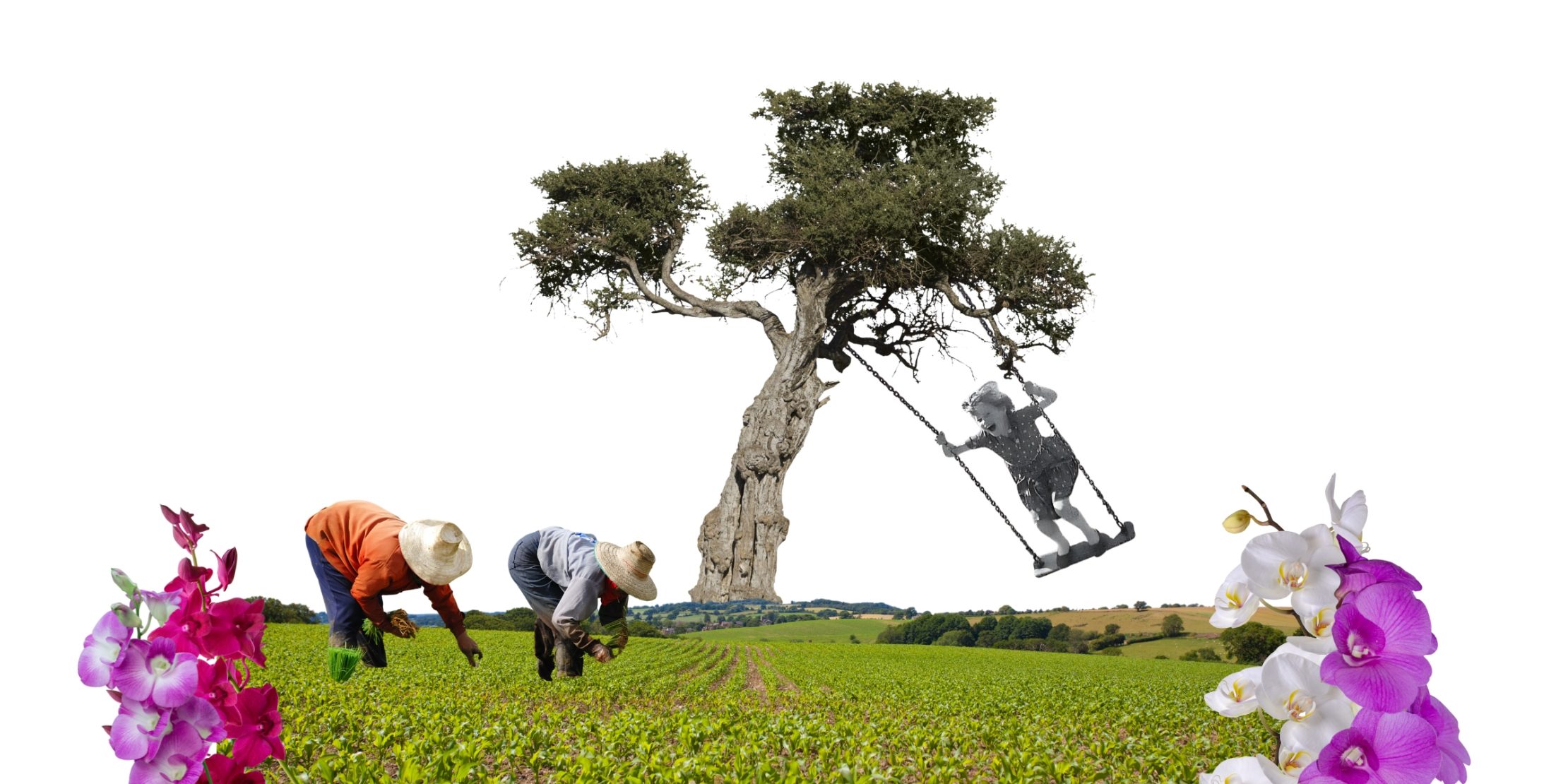

The Global Biodiversity Framework is a plan developed by the United Nations and its member countries to reach the global vision of a world living in harmony with nature by 2050. The framework was adopted by 196 countries in 2022 at the UN Biodiversity Conference (COP15). It sets out 23 specific targets to be achieved by 2030, along with four long-term goals for 2050.
The Global Biodiversity Framework outlines a clear strategy for countries to follow to protect and restore biodiversity. Countries agreed to 23 targets to achieve by 2030 including commitments to conserve 30 percent of land, sea and inland waters, restore 30 percent of degraded ecosystems, halve the introduction of invasive species, and reduce harmful subsidies by US$500 billion per year. In addition, the four long-term goals focus on guaranteeing the health of species and ecosystems and halting extinction, using biodiversity sustainably and sharing the benefits equitably, as well as closing the biodiversity finance gap, which currently amounts to $700 billion per year.

National Biodiversity Strategies and Action Plans (NBSAPs) are national plans that guide the conservation and sustainable use of biodiversity in a country, developed under the Convention on Biological Diversity (CBD).
NBSAPs are essential tools for countries to design and prioritize actions to protect nature and integrate them into national decision-making, economic planning and public policy. They play a particularly crucial role in mainstreaming environmental action and conservation across different sectors of public policy, which is central to achieving each country’s commitments made under the Global Biodiversity Framework and the goals of the CBD. Incorporating mainstreaming as a major feature of the NBSAPs is important because many national environmental focal points are not present in the most influential departments or ministries.
NBSAPs supports countries to align to the 23 targets and four goals of the Global Biodiversity Framework, addressing the need to integrate biodiversity values into government policies, encouraging businesses to assess and disclose their impacts on biodiversity, promoting sustainable consumption, setting clear financial and resource goals that align to a nature-positive future, and ensuring equity, inclusivity and gender justice in biodiversity actions.
Each country that is a signatory to the CBD has to develop an NBSAP, according to its context and capabilities. Since 1993, 191 countries have developed at least one NBSAP.

Nature Positive is a global goal to halt and reverse nature loss by 2030 on a 2020 baseline and achieve full recovery by 2050. In simple terms it means ensuring more nature in the world in 2030 than in 2020 and continued recovery after that.
Actions and strategies to achieve the Nature Positive goal focus on enhancing the resilience of ecosystems, protecting and enriching biodiversity, storing carbon, supporting access to natural resources and reducing health risks for societies to benefit both human well-being and the health of the planet.
Nature Positive requires a shift away from nature-negative practices that degrade nature towards those that restore and sustain it, ensuring that nature's benefits are maintained and protected. By securing nature's vital contributions, a transition to Nature Positive supports sustainable socio-economic development and moves humanity in the direction of a harmonious relationship between human activities and nature’s ecological systems.
Ultimately, reaching Nature Positive will strengthen the resilience of both people and planet, offering a future where ecological health and human thriving go hand in hand.

Editor's Note: If you found this piece useful, check out the first edition of the Climate Dictionary, which breaks down 40 terms and concepts related to climate change.
